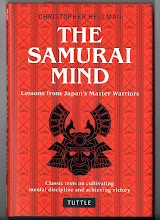 |
| Not by Musashi, but by a contemporay; Kano Sansetsu (1589-1651) indulges his humorous side with this monkey. |
I have written a little on Musashi's monkey design (& Part 2) before, but seeing Kano Sansetsu's version of the theme was too good an opportunity to miss. It reminded me of the mention Musashi makes of the shuko, or Autumn monkey.
The admonition he gives in the sections in both Gorin no Sho and Hyoho 35 Gokajo (35 Articles on Strategy) is not to stretch out the arms in striking, and so the natural assumption (and one followed by the first few translators of A Book of Five Rings) is that it referred to the a short-armed monkey, such as the native Japanese macaque.
I thought so too, but the puzzling question was the use of the term 'Autumn monkey', and several theories have been advanced as to the reason for this. None of them are entirely convincing, but as it was obviously a reference to a short-armed monkey, that didn't seem to matter all that much.
But when it comes to symbolism, all is not as it seems. Although there is a rich tradition of monkey lore in Japan, much of this is related to Shinto traditions, and is quite explicitly attached to specific deities enshrined in particular locations. Given Musashi's links with aspects of culture related to Buddhism, and especially Zen, it seems more likely that he would be drawing from this tradition. His paintings at Toji Temple in Kyoto date from quite early in his career, long before his time in Kumamoto, and it is possible that he had seen or at least heard of the paintings by Hasegawa Tohaku.
 |
| Tohaku's 'Monkey Reaching for the Moon' in Konchi-in |
The fur of the monkey was painted with a brush with split bamboo 'hairs' to create the scratchy, fuzzy appearance, and in this we can see his indebtedness to the work of Mu Qi (Mokkei), the Chinese painter, whose works had been brought to Japan (and kept at Daitokuji Temple in Kyoto) some two hundred+ years previously.
 |
| Mu Qi |
 |
| Hasegawa Tohaku |
We have evidence of Musashi using the image of a gibbon reaching for the moon in his art (in the fittings for a sword), so it seems possible that this is the shuko, rather than the short-armed type. Given the fate of the monkey that stretched out for the moon (it came to an unhappy end) this can clearly serve as a warning of the dangers of so doing. But still, the use of the term Autumn monkey was puzzling. Why Autumn? The answer is, of course, obvious if you think a little more widely. If any season was associated with the moon, it would be Autumn; after all, this was when the yearly moon viewing festival was held. In some circles, the viewers, like the monkey, would view the moon's reflection in the surface of a pond. It makes far more sense to associate the Autumn of Musashi's Autumn monkey with the moon, than with seasonal aspects of monkey behavior.
This suggests that a broader reading of symbols is important if we are to understand the range of meanings they hold. Much of the creativity in Japanese art is to be found in the way in which well-known motifs are reinterpreted, and the richness and layering of meaning is one of the pleasures of art – however limited one's knowledge may be, there is a little thrill when you identify the origins of an image. Oblique references are common and are part of the way knowledge and experience are presented – being able to unpack references enriches the experience of art, offering new and alternative meanings, additional subtleties, and allows the receiver room for creative interpretation.
Traditionally, in Japan, clothes, accessories, plates and bowls, hanging scrolls etc. are all matched with the time of year, according to the motifs of the season – season being not just the major four seasons, but specific times of year, such as cherry blossom time or Boys Day. This is a well-recognized aspect of haiku, for example, but still features in everyday life as well as more artistic pursuits. Unlike the heavy-handed approach we see with festivals such as Halloween and Christmas, when it comes to seasonal decoration, these motifs were seen as the proper work of serious artists, and the cleverness and skill with which they used well-known motifs is a source of enjoyment throughout the year. Even at a simple level, this use of natural motifs is something that Japanese culture is attuned to in a way that western culture is not.
 |
| Sansetsu's monkey is also reaching for the moon, but it is just out of the picture here. |










No comments:
Post a Comment